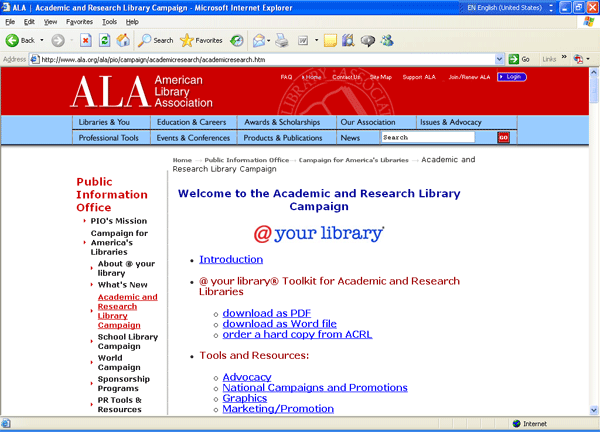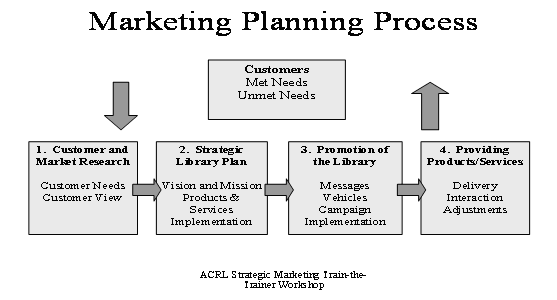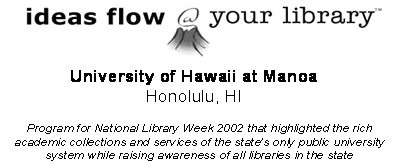
| 
|
|---|
|
Helen H. Spalding
Portland State University Library United States spalding@pdx.edu |
Jian Wang
Portland State University Library United States jian@pdx.edu |
ABSTRACT: The purpose of this paper is to explore the value of marketing in academic libraries and how the marketing concept is applied in practice to marketing academic library services through the experiences of academic libraries across the United States.
Academic libraries have experienced a constant increase of the costs of staffing a library and of purchasing material to support learning and research. At the same time, the costs of higher education are rising. Historically, public universities in the United States received the majority of their funding from tax revenue allocated to them by their state legislatures. In the last decade, however, the percentage of a public university’s budget from the state government has dropped dramatically, forcing them to behave more like private schools that do not receive government support. At the publicly assisted university where the authors of this paper work, less than 15% of Portland State University’s total budget is now from the State of Oregon, although that percentage was 39% in 1992. The rest of the university’s funding must come from student tuition and designated fees, from research grants, from contracts for services, and from private gifts. As a result, both private and public universities must devote time and resources to compete with each other for students, grants, contracts, and donations. University administrations are investing more in marketing consultants and staff to leverage their competitive advantage.
Within the university, offices, academic units, and the library also compete for the funds to be allocated to their budgets so that they can support necessary functions. No department receives enough financial support to do the quantity and quality of work it would like to do on behalf of its students and faculty. Librarians must justify why the university should allocate scarce funds to support library collections and services, rather than hiring more teaching faculty in other academic departments or repairing deteriorating classrooms. The importance of the library cannot be assumed, but must be weighed in relation to other critical needs like classroom and laboratory space, teaching and research faculty, support staff, and student services. Library directors are expected to cultivate individuals who will donate money to the library to help support its work. Librarians are under pressure to write grant proposals to private foundations and to government programs in order to receive outside funding to pay for specific collections or projects.
Managing an academic library is no longer a matter of receiving a budget at the beginning of the fiscal year and making sure that it is not overspent. Now, library administrators must do long range planning to project short and long-term costs and how they will be lowered or paid. They must make strategic decisions concerning how they will generate funding and where they will spend limited resources for staff, facilities, and collections.
Those who work in academic libraries are aware of the misconceptions users and the larger community have about libraries. Many believe that the World Wide Web now provides access to all of the world’s accumulated knowledge. A simple Google search will provide all the relevant information a person may desire about a topic. They do not know that valuable information will never become freely available in machine-readable form and that much digitized information they access is paid by the library. In academic libraries, students do not realize that their password protected access to databases of full-text journals is not information freely available on the Web, but is licensed information to which librarians have negotiated purchased access. Students and faculty are not always aware of the enrichment embedded in the information literacy instruction from librarians can better meet their learning and teaching goals. The general public does not know that it takes a sizeable budget to maintain library facilities, purchase and license rights to collections, and to hire staff with specialized expertise. A majority are not aware of the role academic libraries play in the collection, preservation, and provision of access to materials that no other institution does.
It is not common knowledge that librarians in the United States have earned masters degrees in library science and that many have also received additional graduate degrees that make them specialists in particular subject areas. They need to organize and provide access to original materials in all types of formats and in many languages. University administrations have difficulty understanding the justification for large library budgets, as librarians have not done an adequate job of articulating their value and cost effectiveness to the campus mission.
Graduates at one campus must compete with those from more prestigious institutions for the same graduate school appointments and jobs. Faculty at one campus must compete with those from more prestigious universities for the same research grants, contracts, and positions. They submit articles to the same leading journals in their fields and book manuscripts to the same prominent publishers. Librarians need to make a better case for the value that quality librarians, research collections, and information technology contribute to the competitive ability of students and faculty.
Increasingly, academic libraries are finding that applying marketing principles and techniques can facilitate their strategic planning and goal achievement.[3] An entire journal focusing on the topic, Marketing Library Services, features articles on the importance and means of marketing library service and describes numerous examples of how libraries have implemented marketing techniques to the benefit of their users.[4] Sally Garner Reed’s book, Making the Case for Your Library, gives practical suggestions for library advocacy.[5]
Marketing is centered on the customers, or library users.[6] In order to better meet user needs and communicate effectively with users, market research is required to gather the data upon which strategic decisions and enhancement of services must be based. In a case study from Kenya, Joseph Kavulya emphasizes that marketing is more than advertising what services are available, but also is a process by which research is gathered to inform institutional goals and the strategic actions needed to achieve those goals.[7]
Regular market research about library users not only helps determine what current and future collections and services the users may require, but also provides valuable information about how librarians might best communicate so that users know about and understand how to maximize the potential of the services available to them. Jacqueline M. Roberts did a study to determine how well informed about library services the faculty were at the University of the West Indies. She found that the faculty were aware of only 47% of the library services, creating a false understanding of the library’s usefulness to them.[8] Because the demographics and needs of users change and because new library collections and services continue to be developed, an assumption in any marketing planning is that changes will occur.[9] Once marketing plans are written, they must be regularly revised in light of new information, goals, aspirations, and service enhancements.[10]
As essential as marketing services and collections to library users is, it is equally critical to identify other audiences to whom marketing strategies should be applied. By identifying an audience, such as university administrators or private donors, librarians can use marketing techniques to understand better and consider their particular points of view and values when recruiting their support for library funding. Strategic marketing provides libraries with a process through which audience research can be conducted and its results used to deliver the most relevant product or message in the most audience-appropriate way to capture the attention and understanding of the audience. The results can be an improved delivery of library services and collections, a better funding, or a higher visibility and appreciation from students and faculty as well as those who affect funding and public policy.

| 
|
|---|
In 2002-2003, the Association of College and Research Libraries (ACRL), in partnership with ALA, customized the ALA Campaign for America’s Libraries for academic libraries. Many of the resources developed by ACRL are available over the World Wide Web.[12]

|
|---|
This paper highlights the concepts incorporated in this campaign and provides examples of how some academic libraries have customized for their use the concepts and resources to successfully meet critical local goals. ACRL’s Academic and Research Library Campaign provides tools to assist librarians in better understanding their library users and the services they need, incorporating this information into service improvement, and communicating more effectively what the library can deliver. The process can result in users more satisfied with library service and a wider community who have a greater appreciation for what academic librarians and library resources do to facilitate learning and research.
ACRL member volunteers, with 3M Library Systems (St. Paul, Minnesota), and consultant A. B. Reynolds, developed materials and workshop designs for academic librarians to learn and apply marketing planning in their libraries. The materials are based on the work of Charles D. Schewe and Alexander Hiam, The Portable MBA in Marketing (1998).[13] Available also is the Strategic Marketing for Academic and Research Libraries Facilitator Guide, which is a manual to train librarians to serve as facilitators in workshops where other librarians can learn to use a marketing approach in their libraries. A manual entitled Strategic Marketing for Academic and Research Libraries Participant Manual is also available for the workshop attendees, as well as a guide to train librarians to train other people with use of this material. The manuals are available through the 3M Library Systems web site.[14]
A summary of the program and concepts of the marketing strategic planning process is published in Toolkit for Academic and Research Libraries: messages, ideas, and strategies for promoting the value of our libraries and librarians in the 21st century (2003)[15], which is available for purchase in print from ACRL or to download from the ACRL web site.[16]
With these tools, librarians have guidelines for developing a strategic marketing plan adaptable to meet the unique needs of a library. The toolkit has key messages, outreach strategies, media relationship materials, and communication suggestions. Manuals and worksheets guide librarians through a strategic planning process that can be customized for the individual library’s needs. Also provided at the ACRL web site are downloadable graphics and customizable publicity materials for use in designing bookmarks, newsletters, posters, web sites, etc.
Each of these key messages can be communicated in a variety of ways to specific audiences. Each of them expresses an important role of the academic library in teaching and learning, research, and the collection, organization, and preservation of material for future generations.

| [17] |
|---|
A strategic marketing plan includes:
The Status Inventory worksheet has 26 steps to guide market research on an audience, identify the pieces of the strategic plan, sequence a promotion plan, and prioritize library services for improvement. Through the market research, librarians can learn whether their students know what the library has to offer, whether it is worth students’ time and effort to take advantage of the library services, whether they make good use of the library services, and how they describe the library’s services to others.
As the plan is implemented and library services are delivered, the marketing plan must be adjusted as new data and assessment information are taken into consideration. The process must be integrated into the library routine. The staff must be fully involved and trained so that they have the skills and confidence to design and deliver new services desired by library users. As an organization, it is important to celebrate goal achievement and generate energy and excitement to continue planning for and providing ever improving collections and services. By accurately understanding and targeting an audience with an effective marketing plan, both the library and the users realize mutual success that provides incentive to continue incorporating the process in the library’s operation.
Ideas include the following. At Illinois State University in Normal, Illinois, the library used a clever play on words with the name of the town in which the university is located. In creating a brochure to help raise money for the library, they used the slogan, “Redefining ‘normal’ @ your library®.” The University of Missouri-Kansas City (UMKC) Libraries made large color posters, featuring faculty members with quotes about library services they believe are valuable library services. For example, with the annual marketing theme of “Get It Fast, Get It Friendly @ your library®,” UMKC Pharmacy Professor Dr. Yuen-Sum Lau’s picture is on a poster with a quote from him about how helpful the library is in providing interlibrary loan document delivery directly to his laboratory location. UMKC features their faculty posters in the library and around campus as well as at their web site.[19]
In partnership with sponsors, ACRL is now providing an annual award to an academic library for an outstanding and successful marketing effort. These award winning ideas are shared at the ACRL web site and through press releases so that other libraries may benefit from their experiences. The first winner of the Best Practices in Marketing Academic and Research Libraries @ your library® was American University Library in Washington, D.C. They targeted undergraduates to raise their awareness of services available for them at the library. They used the themes, “Are you in the know?” and created a successful year-long campaign of welcome kits, posters, articles, mugs, and post-it notes. Key messages were, “Ask @ your library®. We can find the books you need.” and “Ask @ your library®. We can save you time.” and “Ask @ your library®. Librarians can make your research simple.”[20]
The University of Hawaii at Manoa drew attention to their services during the National Library Week 2002 with the theme, “Let Ideas Flow @ your library™.” and the picture of lava flowing down from a volcano tip as Hawaii islands are well known for their volcanoes.[21]

|
|---|
[1] Kassel, A. (2002). “Practical Tips to Help You Prove Your Value.” Marketing Library Services, 16(4), 1-4.
[2] Lewis, A. (2000). “Writing a Successful Long-Range Plan for a PL.” Marketing Library Services, 14(5), 1-3.
[3] De Saez, E.E. (2002). Marketing Concepts for Libraries and Information Services. 2nd ed. London: Facet Publications.
[4] Marketing Library Services. Harrod’s Creek, KY: Information Today, Inc.
[5] Reed, S.G. (2001). Making the Case for Your Library: a how-to-do-it manual. New York: Neal Schuman Publishers.
[6] Hoekstra, J.C., Leeflang, P.S.H., & Wittink, D.R. (1999). “The Customer Concept: the basis for a new marketing paradigm.” Journal of Market-Focused Management, 4(1), 43-76.
[7] Kavulya, J.M. (2004). “Marketing of Library Services: a case study of selected university libraries in Kenya.” Library Management, 25(3), 118-126.
[8] Roberts, J.M. (1995). “Faculty Knowledge about Library Services at the University of the West Indies.” New Library World, 96(2), 14-22.
[9] Adeyoyin, S.O. (2005). “Strategic Planning for Marketing Library Services.” Library Management, 26(8/9), 494-507.
[10] Kassel, A. (1999). “How to Write a Marketing Plan.” Marketing Library Services, 13(5), 4-6.
[11] American Library Association. (2006). About the Campaign for America’s Libraries. URL: http://www.ala.org/ala/pio/campaign/aboutyourlibrary/aboutyourlibrary.htm. Viewed 5 May 2006.
[12] American Library Association. (2006). Welcome to the Academic and Research Library Campaign. URL: http://www.ala.org/ala/pio/campaign/academicresearch/academicresearch.htm. Viewed 5 May 2006.
[13] Schewe, C.D., & Hiam, A. (1998). The Portable MBA in Marketing. 2nd ed. New York: Wiley.
[14] Association of College and Research Libraries, 3M Library Systems, and A.B. Reynolds. (2003). @ your library™ Campaign for America’s Library. URL: http://www.ala.org/ala/acrl/acrlissues/marketingyourlib/marketingyour.htm. Viewed 26 July 2006.
[15] American Library Association. (2003). Toolkit for Academic and Research Libraries: messages, ideas, and strategies for promoting the value of our libraries and librarians in the 21st century. Chicago: American Library Association and Association of College and Research Libraries.
[16] American Library Association. (2003). The Campaign for America’s Libraries @ your library ™ -- Tookit for Academic and Research Libraries: messages, ideas, and strategies for promoting the value of our libraries and librarians in the 21st century. URL: http://www.ala.org/ala/pio/campaign/academicresearch/toolkitfinaltext2.pdf. Viewed 5 May 2006.
[17] Association of College and Research Libraries, 3M Library Systems, and A.B. Reynolds. (2003). Strategic Marketing for Academic and Research Libraries Facilitation Slides for the Train-the-Trainer Workshop. URL: http://www.ala.org/ala/acrl/acrlissues/marketingyourlib/marketingyour.htm. Viewed 26 July 2006.
[18] American Library Association. (2006). Getting Started: case histories. URL: http://www.ala.org/ala/pio/campaign/academicresearch/successfulacademic.htm. Viewed 5 May, 2006. More Ideas Too Good Not to Share. URL: http://www.ala.org/ala/pio/campaign/academicresearch/moregoodideas.htm. Viewed 5 May 2006. And Who’s on Board at your library™. URL: http://www.ala.org/ala/pio/campaign/academicresearch/whosboardyour.htm. Viewed 5 May 2006.
[19] University of Missouri-Kansas City Libraries. (2006). [Homepage]. URL: http://www.umkc.edu/lib/. Viewed 5 May 2006.
[20] American Library Association. (2006). 2005 Best Practices in Marketing Academic and Research Libraries @ your library® Award Winners. URL: http://www.ala.org/ala/acrl/acrlissues/marketingyourlib/marketingwinners.htm. Viewed 5 May 2006.
[21] American Library Association. (2006). Who’s on Board at your library™. URL: http://www.ala.org/ala/pio/campaign/academicresearch/whosboardyour.htm. Viewed 5 May 2006.
Jian Wang
Head of Serials Cataloging/Associate Professor
Portland State University Library
P.O. Box 1151, Portland, Oregon 97207-1151
Phone: 503-725-4574, Fax: 503-725-5799
E-mail: jian@pdx.edu
Resubmitted to CLIEJ on 18 July 2006
| Spalding , Helen H., & Wang, Jian. (2006). "Marketing Academic Libraries in USA: Challenges and Opportunities." Chinese Librarianship: an International Electronic Journal, no.22 (December 1, 2006). URL: http://www.iclc.us/cliej/cl22SpaldingWang.htm |